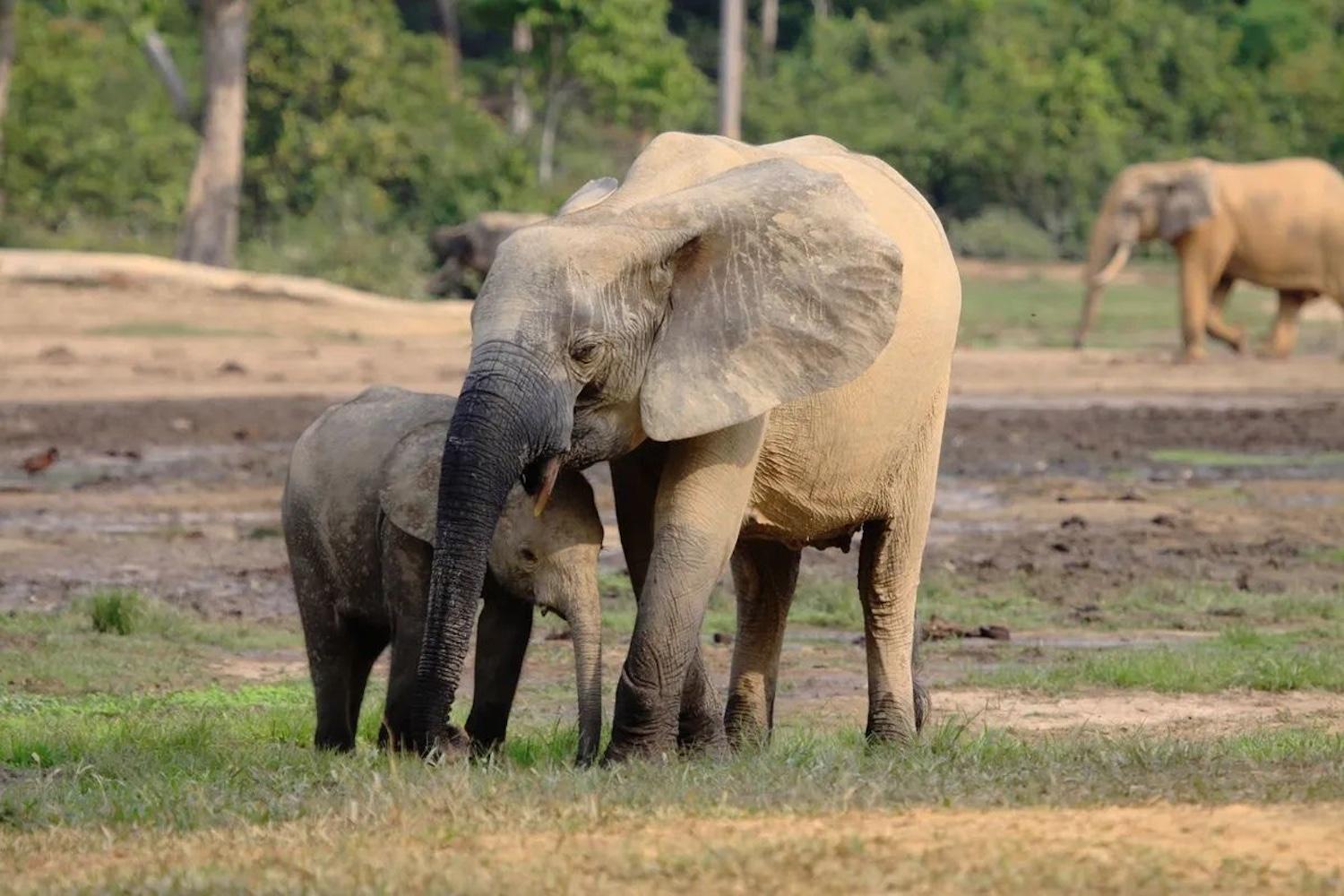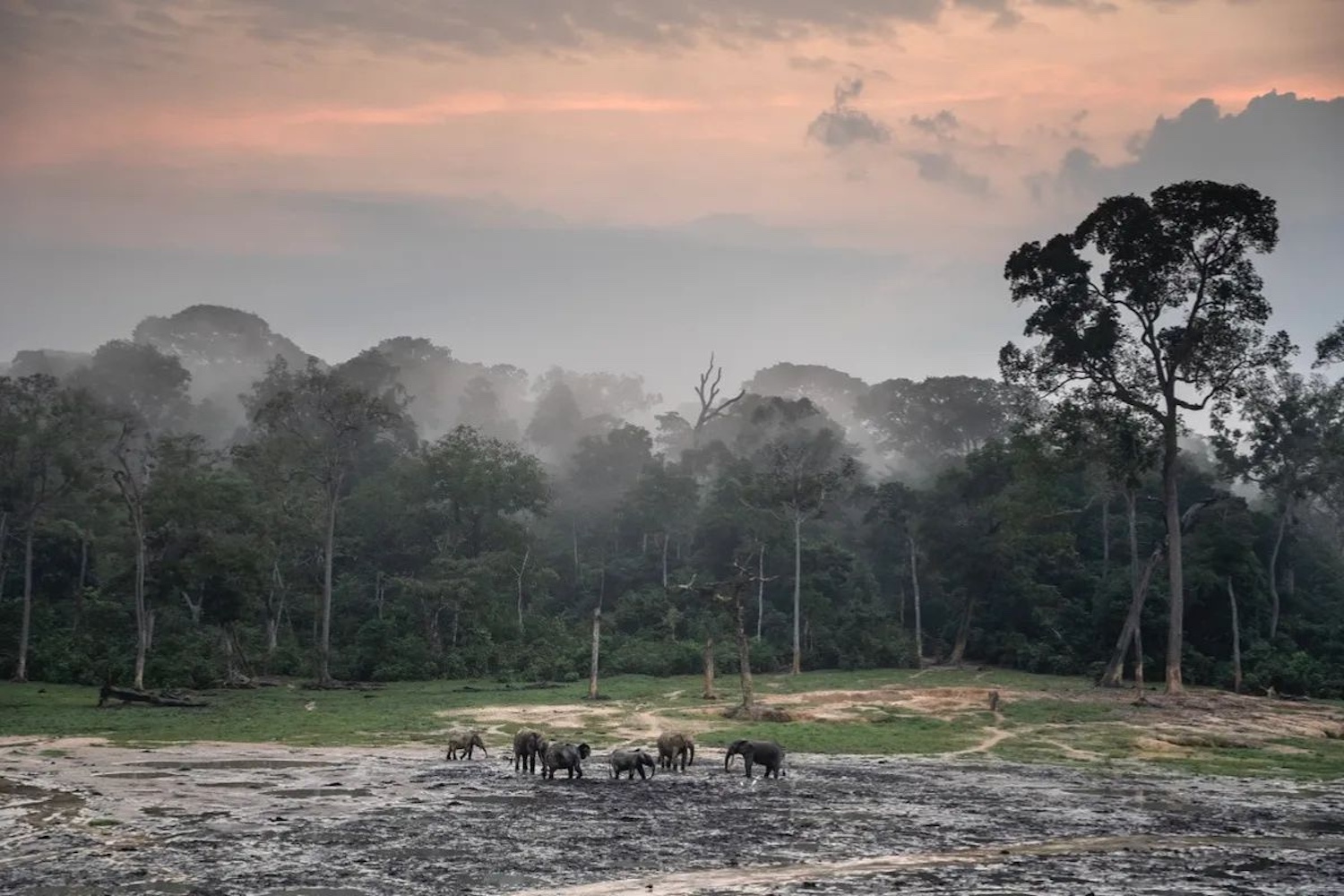
A forest elephant mother and calf in Dzanga Bai, a forest clearing in Dzanga Sangha Protected Area, southwestern Central African Republic. (Image: Carlos Drews for WWF)
After decades of population decline due to ivory poaching and habitat loss, the African forest elephant and African savanna elephant are on the list of endangered and threatened animals. The African forest elephant population, in particular, fell by more than 86 percent over 31 years, according to the International Union for Conservation of Nature, which runs the list.
Monitoring elephants helps conservationists develop more effective protection strategies that contribute to the long-term survival of these mammals. But that’s a severe challenge, especially in the Congo Basin of Central Africa, because the basin is a dense tropical rainforest ecosystem — unlike the African savanna, a grassland ecosystem with open spaces.
“A drone flying over the African savanna forest can identify the animals,” said Thomas Breuer, African forest elephant coordinator at the World Wildlife Fund (WWF) Germany. “But a drone flying over a dense canopy in the Congo won't be able to see through the canopy, so we have to estimate the number of animals.”
The inability to accurately monitor elephant populations left conservationists relying on indirect methods.
“We estimate numbers by counting elephant dung piles in an area, knowing both how many piles an elephant produces daily and how long these piles remain visible,” Breuer said. “We also use camera traps because they help us create individual profiles of the animals. When we spot an elephant at one location and then again 50 kilometers away, we get insight into their movement patterns, which advances our understanding of these animals.”
To monitor elephants more effectively, IBM and WWF announced an initiative leveraging IBM's Maximo Visual Inspection artificial intelligence (AI) technology to identify and monitor individual African forest elephants. The partnership addresses the need for precision and efficiency in tracking one of the world's most endangered species.
The tool uses labeled datasets from camera trap images to train the AI to recognize elephants by their unique physical traits — such as tusk shapes or markings on their bodies. The initial pilot is centered on a key area in the Central African Republic, where camera traps have captured photos of elephants for many years.

“The dataset we're using is unique. Many elephants — similar to those in the Congo Basin — visit this famous natural forest clearing in [Dzanga-Sangha] in the Central African Republic, where we've set up camera traps around the area to monitor known elephants,” said Aditya Khosla, principal product manager for the IBM Environmental Intelligence Suite. “Even though these elephants are difficult to identify, we can assign them identities based on time frames and likely movements. This process enriches our learning data. The dataset's uniqueness comes from tracking elephants we already know. Without this foundation, we might only identify the most distinctive elephants, leaving many unclassified.”
These datasets will help refine the AI model, which will expand to cover forests across the Congo Basin.
“The model needs to understand not just different types of elephants but also identify unique individual elephants,” Khosla said. “We label our datasets to track specific elephants so we know exactly who they are. When we receive new camera trap images, the system can easily recognize elephants it has seen before. This also helps us identify previously unknown elephants.”
By incorporating images captured at different times of day and under varying environmental conditions, the system also improves its ability to detect elephants across diverse scenarios.
African forest elephants play a vital role in maintaining the health of their ecosystems, earning them the nickname "climate heroes." Elephants consume over 400 pounds of food daily, and their foraging habits reshape the forest. As they move, they reduce vegetation density by damaging smaller trees with lower carbon density. This creates space for larger trees with denser wood and wider canopies, which can store more carbon dioxide. Beyond forest clearing, elephants spread seeds from carbon-dense trees through their dung, promoting healthy forest growth. Research shows a single forest elephant can boost the carbon capture capacity of forests by nearly 250 acres, offsetting emissions equivalent to that of 2,047 cars annually.
"The technology will not only help track individual elephants but also provide critical data to support broader ecosystem restoration,” Khosla said. “By quantifying the elephants’ contributions to carbon storage, we can better value and protect these vital animals."
The AI-powered solution will also streamline a traditionally manual process.
“Our team members will no longer need to spend weeks in dangerous swamp conditions, facing threats from snakes and other hazards, to collect this information,” WWF’s Breuer said. “Having experienced this personally along with many others, I can say that finding an alternative to manual counting is already a tremendous improvement.”
Camera traps placed in known elephant habitats capture images continuously. These images are fed into the AI model, enabling conservationists to monitor individual elephants’ movements and population dynamics in near real-time.
“Consider that with this method we'll be able to identify 70 percent of elephants in a given area,” Breuer said. “This 30 percent margin of error is minimal compared to our current indirect counting methods.”
While the immediate goal is to monitor elephant populations, the broader implications of the technology are profound. By integrating this data with IBM's Environmental Intelligence Suite, a set of tools designed for those working with environmental data to increase climate resilience and business efficiency, the project aims to assess the impact of elephant activities on forest growth. This could provide a clearer picture of how nature contributes to carbon capture and broader ecosystem services.
“I'm confident that combining this AI tool with our expertise in direct observation, fieldwork, and manual identification will make the system even more accurate,” Breuer said. “We'll not only be able to measure the impact of our conservation efforts but also track individual movements, especially of larger male elephants, between locations. This helps us identify crucial wildlife corridors. The impact on conservation is significant. We will be able to determine elephant populations in specific locations with unprecedented precision.”
Breuer further envisions a future where this technology can transform conservation strategies globally.
“We've planned a two-year collaboration with IBM to develop and refine this technology,” he said. “I believe this partnership is truly groundbreaking and will revolutionize conservation in the Congo Basin.”
For WWF and IBM, success will be measured in elephant counts and the depth of insights generated. The project’s first phase aims to identify individual elephants in two pilot forests, with plans to expand regionally over the next two years.
"Ultimately, we hope to integrate AI insights with carbon credit frameworks, ensuring the economic value of protecting elephants is recognized and supported,” Khosla said.

Abha Malpani Naismith is a writer and communications professional who works towards helping businesses grow in Dubai. She is a strong believer in the triple bottom line and keen to make a difference. She is also a new mum, trying to work out a balance between thriving at work and being a mum. In her endeavor to do that, she founded the Working Mums Club, a newsletter for mums who want to build better careers and be better mums.














